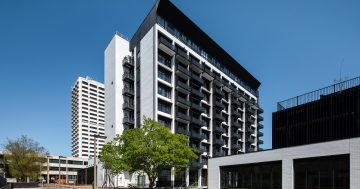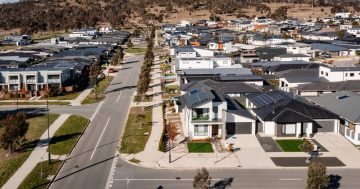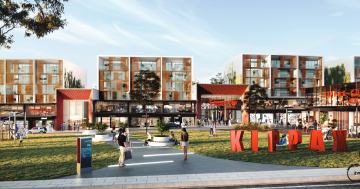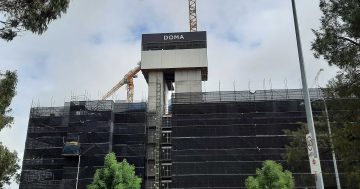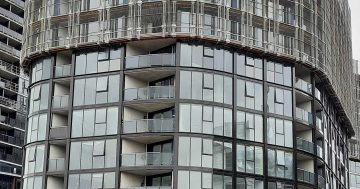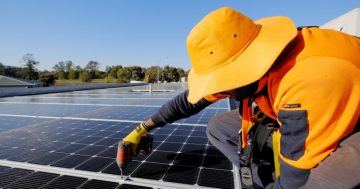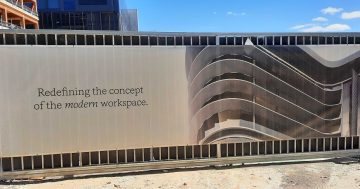 ACT Minister for Water, Energy and Emissions Reduction Shane Rattenbury, Property Council ACT executive director Shane Martin and Green Building Council of Australia CEO Davina Rooney at the launch of the Every Building Counts report. Photo: Supplied.
ACT Minister for Water, Energy and Emissions Reduction Shane Rattenbury, Property Council ACT executive director Shane Martin and Green Building Council of Australia CEO Davina Rooney at the launch of the Every Building Counts report. Photo: Supplied.Governments should allow developers to increase the height and density of their projects if they exceed environmental standards, according to the Property Council and the Green Building Council.
Development applications should also be fast-tracked for projects that meet high sustainability requirements.
These recommendations come in a new report launched in Canberra this week, which sets out 40 policies for state and territory governments to consider to facilitate the rapid development of energy-efficient, all-electric new buildings.
Property Council ACT executive director Shane Martin said a “key pillar” of the Every Building Counts report is its call for governments to adopt incentives to encourage developers to plan sustainably.
The report also recommends finance mechanisms such as ‘green mortgages’ and stamp duty and land tax concessions for high-performing buildings.
Other key policy recommendations in the report include incentivising energy efficiency and electrification retrofits for existing homes, minimum performance standards for rental properties, and mandatory disclosure of energy efficiency at the point of sale.
The report said implementing planning incentives would come at a low cost to governments and would have a number of benefits for developers.
“Planning incentives … would support the accelerated deployment of high-performing new buildings by targeting one of the highest priorities for building developers – the cost and time invested and the uncertainty of planning processes,” the report said.
Mr Martin said increasing the density of residential projects to develop more sustainable and higher-performing buildings “just makes sense” as it provides more homes that are comfortable and energy efficient to live in.
“Our view is if the ACT Government, along with other state and territory governments, take this up, we can continue the momentum that we currently have because through height bonuses and density bonuses, when it comes to buildings, we can effectively scale up our progress and we can lead towards the incentivisation of construction of high-performing buildings,” he added.
“Do we think about a generator in the basement, or do we increase the height to put some sort of generator or solar on the top and add an extra floor on top of that, which will just make it stack up feasibility-wise and allow much more kind of high performing buildings to be constructed?”
Mr Martin said this is particularly important to consider when it comes to commercial office space.
“In the ACT, we obviously have quite large tenants with the Federal Government.
“Federal governments are moving towards wanting their own green leases as well. We need to constantly keep pace, and the property industry wants to keep pace as well.”
Mr Martin said with the ACT’s new outcomes-based planning system, there could be an opportunity to consider ‘green door policies’ where development applications for sustainable buildings are fast-tracked.
“Here in the ACT, some other things could be the way we look at green door policies … Do we look at ways of essentially fast-tracking [DA approval] for buildings that are showing they’re above the general type in terms of their sustainability and their electricity driven nature?
“If this is an outcomes-based planning system, could we look at ways of speeding up and fast-tracking DAs for those high-performing buildings looking nationally?”
ACT Minister for Water, Energy and Emissions Reduction Shane Rattenbury said he “really welcomed” the report’s recommendations.
“What [the Green Building Council and the Property Council] are demonstrating is real leadership in outlining the long-term future of buildings in Australia,” he said.
“Buildings are a big source of energy use and therefore emissions and planning now to have zero-emission buildings in the future is a really important moment to begin early and to make sure we know where we’re going in setting up this vision.
“Buildings, of course, last for a long time, so the buildings we’re building today will still be here in 2045 and 2050 when Australia expects to be net zero, so we need to be getting it right now.”
Mr Rattenbury said a key focus for the ACT Government has been creating a long-term agenda to give the construction industry more certainty.
“This something that the ACT Government is positioned to be able to implement. The report is very positive in that it creates a long-term vision and what we need in this space is certainly a clear plan to get us to net zero to decarbonise our buildings.”












